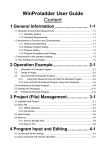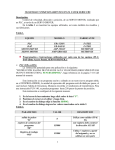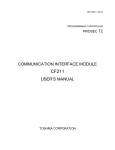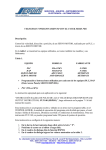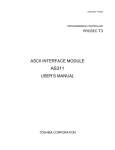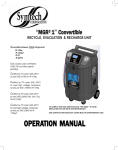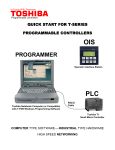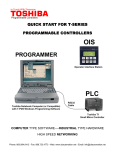Download Toshiba CD332 Network Card User Manual
Transcript
UM-TS03∗∗∗-E024 PROGRAMMABLE CONTROLLER PROSEC T3 CHANGE DETECT DC INPUT MODULE CD332 USER’S MANUAL TOSHIBA CORPORATION Important Information Misuse of this equipment can result in property damage or human injury. Because controlled system applications vary widely, you should satisfy yourself as to the acceptability of this equipment for your intended purpose. In no event will Toshiba Corporation be responsible or liable for either indirect or consequential damage or injury that may result from the use of this equipment. No patent liability is assumed by Toshiba Corporation with respect to use of information, illustrations, circuits, equipment or examples of application in this publication. Toshiba Corporation reserves the right to make changes and improvements to this publication and/or related products at any time without notice. No obligation shall be incurred other than as noted in this publication. This publication is copyrighted and contains proprietary material. No part of this book may be reproduced, stored in a retrieval system, or transmitted, in any form or by any means ⎯ electrical, mechanical, photocopying, recording, or otherwise ⎯ without obtaining prior written permission from Toshiba Corporation. © TOSHIBA Corporation 1996. All rights reserved Publication number: UM-TS03∗∗∗-E024 1st edition August 1996 PROSEC is a registered trademark of TOSHIBA Corporation. Safety Precautions This module (CD332) is a change detect DC input module for Toshiba’s Programmable Controller PROSEC-T3 or T3H (hereafter called T3 generically). Read this manual thoroughly before using this module. Also, keep this manual and related manuals so that you can read them anytime while this module is in operation. Safety Symbols The following safety symbols are used on the product and/or in the related manuals. Pay attention to information preceded by the following symbols for safety. ! WARNING Indicates a potentially hazardous situation which, if not avoided, could result in death or serious injury. ! CAUTION Indicates a potentially hazardous situation which, if not avoided, may result in minor or moderate injury. It may also be used to alert against unsafe practices. Safety Precautions ! CAUTION • Turn off power to the T3 and to the CD332 before removing or mounting the CD332. Failure to do so can cause electrical shock or damage to this product. • Read the Safety Precautions described in the T3 User’s Manual before using the T3 and the CD332. • Follow the instructions described in this manual and in the T3 User’s Manual when installing and wiring the T3 and the CD332. • The CD332 has been designed for the T3. Use your CD332 only on the rack of the T3. • Remove the CD332 from the rack before setting the jumper plugs on the CD332. Do not touch other components on the CD332’s printed circuit board. It may cause damage to the CD332. • The CD332 consumes maximum 0.3 A of internal 5 Vdc power. Confirm that the total 5 Vdc consumed current per one power supply module is within the limit (7A). If it exceeds the limit, the T3 cannot operate properly and this may cause unsafe situation. User’s Manual 1 About This Manual About This Manual This manual explains the specifications and operations of the Change Detect DC Input Module (CD332) for Programmable Controller T3. Read this manual carefully before using the CD332. Inside This Manual Section 1 Overview This section introduces the CD332. The CD332 has an interrupt generation function for the T3. This section outlines the CD332’s function. The external features of the CD332 are also provided in this section. Section 2 Specifications This section provides the hardware and functional specifications of the CD332. The information for external wire connections is also provided in this section. Section 3 Mode Setting The input delay time and the interrupt generation timings are user selectable. This section explains the switch settings for this purpose. Section 4 I/O Allocation This section provides the information to design T3 program for the CD332. This section explains the I/O allocation and functions of the I/O register assigned to the CD332. Section 5 Programming The CD332 generates an interrupt signal for the T3. This section provides T3’s sample program for the CD332. Precautions for using the interrupt function are also explained in this section. 2 Change Detect DC Input Module (CD332) About This Manual Related Manuals The following related manuals are available for T3. Besides this manual, read the following manuals for your better understanding. T3 User’s Manual - Hardware This manual covers the T3’s main body and basic I/O - their specifications, handling, maintenance and services. T3 User’s Manual - Functions This manual explains the functions of the T3 and how to use them. The necessary information to create user program is covered in this manual. T3H User’s Manual This manual explains the specifications of the T3H and the functional differences between the T3H and the T3. T-series Instruction Set This manual provides the detailed specifications of instructions for Toshiba’s T-series Programmable Controllers. T-series Computer Link Function This manual provides the information for a computer to communicate with T3 through the T-series Programmable Controller’s Computer Link function. T-PDS (Ver. 1.4) Basic Operation manual This manual explains how to install the T-series program development system (T-PDS) into your computer and provides basic programming operations. T-PDS (Ver. 1.4) Command Reference Manual This manual explains the T-series program development system (T-PDS) in detail. T-PDS (Ver. 1.6) Expanded Functions This manual explains the expanded functions on the T-PDS version 1.6. This manual supplements the T-PDS (Ver.1.4) Command Reference Manual. T-series Handy Programmer (HP911) Operation Manual This manual explains the functions and key operations of the T-series Handy Programmer (HP911). NOTE Other than the listed above, some T3 related manuals for special I/O modules and data transmission modules are available. Contact Toshiba for more information. User’s Manual 3 Contents Contents Safety Precautions ...................................................................................... 1 About This Manual ...................................................................................... 2 ..................................................................................................... 4 Contents 4 1. CD332 Overview ............................................................................. 5 1.1 1.2 Introduction ...................................................................................... External features .............................................................................. 6 7 2. Specifications ................................................................................ 9 2.1 2.2 2.3 2.4 General specifications .................................................................... Functional specifications ................................................................. Input circuit .................................................................................... Input signal connections ................................................................. 10 10 11 11 3. Mode Setting ................................................................................. 13 3.1 3.2 Input delay setting ........................................................................... Interrupt generation timing setting ................................................... 14 15 4. I/O Allocation ................................................................................. 17 4.1 4.2 I/O allocation and I/O register ......................................................... Interrupt assignment ....................................................................... 18 20 5. Programming ................................................................................ 21 5.1 5.2 T3 sample program Interrupt operation ......................................................................... .......................................................................... 22 24 Change Detect DC Input Module (CD332) Section 1 CD332 Overview 1.1 Introduction, 6 1.2 External features, 7 User’s Manual 5 1. CD332 Overview 1.1 Introduction The change detect DC input module CD332 (hereafter called CD332) is an 8 points 12 - 24 Vdc input module with interrupt generation function for Toshiba’s Programmable Controller PROSEC-T3 or T3H (hereafter called T3 generically). When the input signal status of the CD332 is changed, the CD332 generates an interrupt for the T3. Then the T3 immediately stops ordinary operation and starts to execute the pre-assigned I/O interrupt program. The task switching time in the T3 is less than 500 µs. (under interrupt enable state) The interrupt generation timing of the CD332 can be selected as follows for each input point. This selection is made by the DIP switches provided on the front of the CD332. (1) Rising edge (from OFF to ON) (2) Falling edge (from ON to OFF) (3) Both edges (both OFF to ON and ON to OFF) This CD332 has 8 input points. By using one CD332, up to 8 interrupt factors can be processed. On the other hand, up to 8 I/O interrupt programs are available in the T3. Therefore, total up to 64 (= 8 × 8) interrupt factors can be processed by the T3 by using 8 CD332s. The input voltage of the CD332 is 12 to 24 Vdc. The input delay time can be selected either normal or high speed as 8 points block by setting the internal jumper plugs. NOTE 6 The T3 supports 8 I/O interrupt programs. Therefore, maximum 8 CD332s can be used with the T3. Change Detect DC Input Module (CD332) 1. CD332 Overview 1.2 External features CD332 DATA 0 1 2 3 4 5 6 7 Status LEDs STATUS 0 1 2 3 4 5 6 7 CHANGE DETECT UP IN0 1 2 3 4 5 6 7 ON Interrupt timing setting DIP switches DOWN IN0 1 2 3 4 5 6 7 ON NC NC IN0 IN1 IN2 IN3 IN4 IN5 IN6 IN7 COM 1 2 3 4 5 Input terminals 6 7 8 9 10 11 NOTE Do not connect any wires to the NC terminals. CD332 User’s Manual 7 1. CD332 Overview Status LEDs Indicates the input signal ON/OFF status (DATA 0 - 7) and the interrupt generation point (STATUS 0 - 7). Normally STATUS 0 - 7 are all OFF. (momentary ON) DATA 0 - 7 STATUS 0 - 7 Indicates the input signal status of IN0 to IN7. Lit when ON. Indicates the input point which is the interrupt factor. (returned to OFF by resetting the interrupt flag) Interrupt timing setting DIP switches Total 16 switches are provided. These switches are used to set the interrupt generation timing for each input point. (Rising, falling or both edges) Refer to section 3.2. Input terminals Used to connect the external input signals. Refer to section 2.4. NOTE Do not connect any wires to the NC terminals. Jumper plugs CD332 rear view Jumper plugs for selecting the input delay are provided. Refer to section 3.1. 8 Change Detect DC Input Module (CD332) Section 2 Specifications 2.1 2.2 2.3 2.4 General specifications, 10 Functional specifications, 10 Input circuit, 11 Input signal connections, 11 User’s Manual 9 2. Specifications 2.1 General specifications Item Power voltage Current consumption Environmental conditions Withstand voltage Size Weight Specifications 5 Vdc (supplied from back plane bus) 0.3 A (5 Vdc) maximum Conforms to T3 specifications 1500 Vac - 1 minute T3 I/O module size (1 slot) Approx. 450 g Remarks Note (1) Note (2) Note (1) The T3’s power supply module can supply maximum 7 A of internal 5 Vdc. Check that the internal 5 Vdc current consumption per one power supply module does not exceed the limit. Note (2) Between external terminals and internal circuit. 2.2 Functional specifications Item Module type I/O allocation type Input type Number of input points Rated input voltage Input voltage range Rated input current Minimum ON voltage Maximum OFF voltage ON delay time OFF delay time LED display DATA 0 - 7 STATUS 0 - 7 Interrupt function Number of modules on T3 Specifications Change detect DC input iX 1W DC input, current source/sink 8 points (8 points/common) 12 - 24 Vdc 10 - 30 Vdc 10 mA (at 24 Vdc) 9.6 Vdc 3.5 Vdc 30 ms or less (normal mode) 3.0 ms or less (high speed mode) 35 ms or less (normal mode) 3.5 ms or less (high speed mode) Input status display for all points, lit at ON, internal logic side Interrupt point display, returned to OFF by resetting the interrupt flag Generates interrupt signal for T3 when input status of each point is changed. Interrupt timing can be selected for each point either rising, falling or both edges. Max. 8 modules Remarks Note (1) Note (1) Note (2) Note (1) The normal or high speed mode can be selected by internal jumper plug settings. Refer to section 3.1. The delay time includes the input filter and internal sampling. Note (2) The interrupt timing is selected by DIP switches. Refer to section 3.2. 10 Change Detect DC Input Module (CD332) 2. Specifications 2.3 Input circuit 2.4 kΩ LED display IN0 470 Ω 1.5 µF IN1 Interrupt IN7 COM 2.4 Input signal connections Input terminal block 1 2 IN0 IN1 IN2 3 4 5 IN3 6 IN4 7 IN5 8 IN6 9 IN7 10 COM Do not connect any wire 11 12 - 24 Vdc User’s Manual 11 12 Change Detect DC Input Module (CD332) Section 3 Mode Setting 3.1 Input delay setting, 14 3.2 Interrupt generation timing setting, 15 User’s Manual 13 3. Mode Setting 3.1 Input delay setting The input delay time of the CD332 can be selected either normal or high speed mode. Refer to section 2.2 for the delay time of each mode. The input delay setting is made by the jumper plugs provided on the CD332’s printed circuit board. This setting is applied for all 8 input points as a block. CD332 left side J9 A B A J10 B J11 J1 J2 J3 J4 J5 J6 J7 J8 Set these jumper plugs as follows. Mode Normal mode High speed mode NOTE 14 J1 J2 J3 J4 J5 J6 ON (short) OFF (open) J7 (1) The factory setting is the normal mode. (2) Use a pair of tweezers to set the jumper plugs. (3) J9 must be always OFF (open). Change Detect DC Input Module (CD332) J8 J9 J10 J11 OFF B side OFF A side 3. Mode Setting 3.2 Interrupt generation timing setting The interrupt generation timing of each input point can be selected either rising, falling or both edges. • Rising edge (OFF to ON) Input OFF ON OFF ON OFF Interrupt • Falling edge (ON to OFF) Input OFF Interrupt • Both edges (OFF to ON and ON to OFF) Input OFF ON OFF Interrupt This setting is made by the DIP switches provided on the front of the CD332. CHANGE DETECT Mode Rising edge Falling edge Both edges UP IN0 1 2 3 4 5 6 7 ON DOWN IN0 1 2 3 4 5 6 7 NOTE UP ON OFF ON DOWN OFF ON ON (1) This setting is available for each input point individually. (2) The factory setting is all ON. (Both edges) (3) Changes of the DIP switches are effective while power on. ON User’s Manual 15 16 Change Detect DC Input Module (CD332) Section 4 I/O Allocation 4.1 I/O allocation and I/O register, 18 4.2 Interrupt assignment, 20 User’s Manual 17 4. I/O Allocation 4.1 I/O allocation and I/O register The CD332 has the I/O type ‘i X 1W’ for I/O allocation. When the automatic I/O allocation is performed with mounting the CD332, the following I/O allocation table will be created in the T3. (T-PDS screen example - in the case that CD332 is mounted on Slot 0 of Unit 0) Then, one input register, XW(n) is assigned to the CD332. In the above example, XW000 is assigned. Note that the I/O type has ‘i’ designation. It means that the CD332 has interrupt generation function for the T3, also the T3 will not update the assigned input register in the batch I/O processing. To read data through the input register, the Direct I/O instruction (FUN235) is necessary. 18 Change Detect DC Input Module (CD332) 4. I/O Allocation The following table shows the function of each bit of the input register assigned to the CD332. F E D C B A 9 8 7 6 5 4 3 2 1 0 XW(n) Status Register XW(n) Data Bit Name Description 0 IN0 Indicates ON/OFF status of input IN0 1 IN1 Ditto IN1 2 IN2 Ditto IN2 3 Data IN3 Ditto IN3 4 IN4 Ditto IN4 5 IN5 Ditto IN5 6 IN6 Ditto IN6 7 IN7 Ditto IN7 8 IN0 Comes ON when interrupt is generated by 9 IN1 Ditto A IN2 Ditto B Status IN3 Ditto C IN4 Ditto D IN5 Ditto E IN6 Ditto F IN7 Ditto IN0 changing IN1 changing IN2 changing IN3 changing IN4 changing IN5 changing IN6 changing IN7 changing The data of the CD332 can be read into the XW(n) register by using the Direct I/O instruction (FUN235). By executing the Direct I/O instruction, the interrupt flag (interrupt request) is reset to OFF internally, and at the same time, the status bits are reset to OFF inside the CD332. User’s Manual 19 4. I/O Allocation 4.2 Interrupt assignment The T3 has 8 I/O interrupt programs, I/O#1 to I/O#8. If one interrupt generation module (CD332) is used, the I/O#1 program is assigned to the CD332. And the I/O#1 is activated when the CD332 generates an interrupt. If two or more (up to 8) interrupt generation modules (CD332, etc.) are used, the interrupt programs are assigned sequentially from the module allocated closest to the T3 CPU. For example, if 3 CD332s are used, the I/O#1, I/O#2 and I/O#3 are assigned sequentially as follows. T3 basic unit 0 1 2 3 4 5 6 7 8 9 P I C C C S F P D D U 3 General 3 General I/O I/O 3 3 2 2 I/O#1 I/O#2 Expansion unit 0 1 2 3 4 5 6 7 8 9 10 P I C S F D 3 3 2 General I/O I/O#3 As for the interrupt priority, the interrupt generation module which is allocated closest to the T3 CPU has highest priority and followed by this order. NOTE 20 In default, the T3’s I/O interrupt program and the interrupt generation module are related as mentioned above. However user can change this relation (assignment) by using the interrupt assignment function of the T3. For this function, refer to the T3 User’s Manual - Function. Change Detect DC Input Module (CD332) Section 5 Programming 5.1 T3 sample program, 22 5.2 Interrupt operation, 24 User’s Manual 21 5. Programming 5.1 T3 sample program The following sample program configuration shows the case of one CD332 is used. In this example, it is assumed that XW000 is assigned to the CD332. Main Program c User program (Main program) d I/O Interrupt Program #1 (I/O#1) e Processing for IN0 interrupt Processing for IN1 interrupt Processing for IN2 interrupt Processing for IN3 interrupt f Processing for IN4 interrupt Processing for IN5 interrupt Processing for IN6 interrupt Processing for IN7 interrupt g 22 Change Detect DC Input Module (CD332) 5. Programming c At the first scan, initializes the status of the CD332. − Important d End of the main program e Resets the interrupt flag and confirms the interrupt factor. − Important f Processing program for each interrupt factor (Subroutine call can also be used) g End of the interrupt program NOTE When the Direct I/O instruction for the CD332 is executed, the internal interrupt flag of the CD332 is reset. Therefore, do not use the Direct I/O instruction for the CD332 on the main program, except c above. User’s Manual 23 5. Programming 5.2 Interrupt operation The enable/disable of the interrupt program is changed as follows. PLC mode HALT Scan Interrupt RUN 1 HOLD RUN 2 Disable n Enable Disable (Hold) HALT n+1 Enable Disable Time In the RUN mode, interrupt operation is disabled at the first scan, and enabled from the second scan. In the HALT mode, interrupt operation is disabled. In the HOLD mode, interrupt operation is disabled but the interrupt requests occurred during HOLD mode is held. During interrupt program execution, other interrupts are disabled, and the interrupt request is held as follows. PLC mode HALT RUN HALT Interrupt program Execution Scan Interrupt 1 Disable 2 n Enable n Disable (Hold) n+1 n+2 Enable Disable Time Note) The held interrupt requests are accepted when interrupt status is changed to enable, according to the priority as follows. (Timer interrupt → I/O#1 → I/O#2 → … → I/O#8, in default) 24 Change Detect DC Input Module (CD332) 5. Programming The interrupt operation can be controlled by the user program instructions, DI (disable interrupt) and EI (enable interrupt). If a part of program is required to be executed under interrupt disable state, these instructions can be used. When using these instructions, note the following precautions. • On the T3 program, interrupt enable/disable can be controlled by using EI instruction (FUN140) and DI instruction (FUN141). These instructions should be used in a pair in the sequence of DI first and followed by EI. (Main program) A [ DI ] Interrupt is disabled (interrupt signal is held) A [ EI ] • EI and DI instructions should not be used in interrupt program. Also, these instructions should not be executed in the first scan. When using the interrupt function, the following general precautions should be considered. • The high frequency of the interrupt generation will cause T3 inoperative. Because, in such case, the T3 becomes busy to execute the interrupt program, and cannot execute the main program. • When the CD332 is used, pay attention to the external noise environment. Especially, when using the high speed response mode, check this point carefully. User’s Manual 25 26 Change Detect DC Input Module (CD332) TOSHIBA INTERNATIONAL (EUROPE) LTD. 1 Roundwood Avenue Stockley Park, Uxbridge Middlesex, ENGLAND UB11 1AR Tel: 0181-848 4466 Fax: 0181-848 4969 TOSHIBA INTERNATIONAL CORPORATION Industrial Division 13131 West Little York Road Houston, TX. 77041, U.S.A. Tel: 713-466-0277 Fax: 713-466-8773 TOSHIBA INTERNATIONAL CORPORATION PTY. LTD. Unit 1, 9 Orion Road, Lane Cove N.S.W. 2066, AUSTRALIA Tel: 02-428-2077 TOSHIBA CORPORATION Industrial Equipment Department 1-1, Shibaura 1-chome, Minato-ku Tokyo 105, JAPAN Tel: 03-3457-4900
































